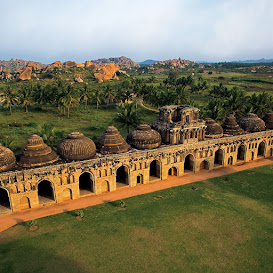The Glorious History of Hampi – Capital of Vijayanagara Empire
The Glorious History of Hampi – Capital of Vijayanagara Empire
Hampi, located in present-day Karnataka, India, is a UNESCO World Heritage Site known for its breathtaking ruins, sacred temples, and rich cultural history.
Hampi was the capital of the Vijayanagara Empire from the 14th to the 16th century, and its ruins, now a UNESCO World Heritage Site, are a testament to its past glory. The city flourished as a center of trade and art, attracting merchants from across the globe, but was ultimately conquered and abandoned after the Battle of Talikota in 1565.
Ancient Roots
Long before empires rose, Hampi—then known as Pampa Kshetra—was a religious center connected to Hindu mythology, especially the Ramayana. It’s believed to be the monkey kingdom of Kishkindha, where Lord Hanuman was born.
Hampi's history is deeply rooted in both mythology and a powerful empire. It is believed to be the ancient site of Kishkindha from the Ramayana, and later became the capital of the Vijayanagara Empire. This empire, known for its wealth and architectural achievements, flourished for over two centuries before being conquered and abandoned.
Rise of the Vijayanagara Empire (1336 CE)
Founded by Harihara I and Bukka Raya I, with guidance from sage Vidyaranya, the Vijayanagara Empire chose Hampi as its grand capital. The empire resisted Islamic invasions and became a center for Hindu art, culture, and architecture.
The Vijayanagara Empire, a powerful Hindu empire in South India, rose to prominence in the 14th century, primarily in response to the expansion of the Delhi Sultanate and the Bahmani Sultanate. Founded by Harihara I and Bukka Raya in 1336, the empire's capital was Vijayanagara, located in present-day Karnataka.
Golden Age (14th – 16th Century)
The empire reached its peak under Krishnadevaraya, one of India’s greatest rulers. Hampi became a hub of:
International trade with Persia, Portugal, and China
Grand architecture like Virupaksha and Vittala Temples
Flourishing literature in Sanskrit, Telugu, Kannada, and Tamil
The 14th-16th centuries saw several "golden ages" across different regions and cultures. In England, the Elizabethan era (1558-1603) is often called a golden age due to relative peace, prosperity, and the flourishing of arts, literature, and theater. The Timurid Renaissance in Central Asia (late 14th-early 16th centuries) also marked a revival of arts and sciences. Additionally, the Polish Golden Age (14th-16th centuries) saw significant architectural and artistic developments.
The Fall (1565 CE)
In the Battle of Talikota, Deccan Sultanates attacked and destroyed Hampi. The city was looted and left in ruins, marking the end of the empire.In 1565 CE, the Vijayanagara Empire experienced a significant decline following the Battle of Talikota on January 23rd. This battle, fought between the Vijayanagara Empire and the Deccan Sultanates, resulted in a decisive defeat for Vijayanagara and led to the empire's eventual fall.
Rediscovery & Legacy
Rediscovered by British archaeologists in the 19th century, Hampi today stands as a living museum of India’s golden past. It draws tourists, history lovers, and spiritual seekers alike.
Rediscovery and legacy, in various contexts, often refer to the process of uncovering or reclaiming something from the past, and the lasting impact or influence that something has on the present and future. This can involve historical, cultural, scientific, or personal aspects.
Must-Visit Ruins in Hampi
Virupaksha Temple
The Virupaksha Temple, located in Hampi, Karnataka, is a significant Hindu temple dedicated to Lord Shiva, also known as Virupaksha. It's a 7th-century temple that has been expanded and renovated over centuries, particularly during the Vijayanagara Empire. The temple is a UNESCO World Heritage Site and a major pilgrimage center.
Vittala Temple & Stone Chariot
The Vitthala Temple (also known as Shree Vijaya Vitthala Temple or Vittala Temple) is a temple dedicated to Lord Vitthala, an incarnation of Lord Vishnu, located in Hampi, Karnataka, India. It is a UNESCO World Heritage Site and a prominent example of Vijayanagara architecture. The temple is known for its intricate stone carvings, the iconic stone chariot, and the musical pillars in the Ranga Mandapa.
Hazara Rama Temple
Hazara Rama Temple is a dominant shrine in Karnataka. This small but beautiful place of worship dedicated to Lord Rama is located at the center of the royal area of Hampi. The temple which was the private temple of the kings of Vijayanagara is popular for the lovely relics and panels depicting the story of the epic Ramayana.
Elephant Stables
The Elephant Stable in Hampi is an impressive structure that was used to provide shelter for the royal elephants of the Vijayanagara Empire. The elephant stable is located in the area that lies just outside the Zenana Enclosure
Royal Enclosure
The stone chariot of the Vittala Temple and the temple’s musical pillars may be the most recognizable architectural structure in Hampi but they are far from being the only ones. On the banks of the River Tungabhadra, Hampi is home to a number of Jain and Hindu temples, aqueducts and the Royal Enclosure spread over 59000 square meters. This was once upon a time, the home of the Vijayanagara King and his Queens. Today the enclosure lies largely in ruins but still speaks loudly of the life it once contained.
Final Thoughts
Hampi isn't just a bunch of ruins—it’s a time capsule of a glorious civilization that once led India’s cultural revival. A walk through Hampi is a walk through history.










Comments
Post a Comment